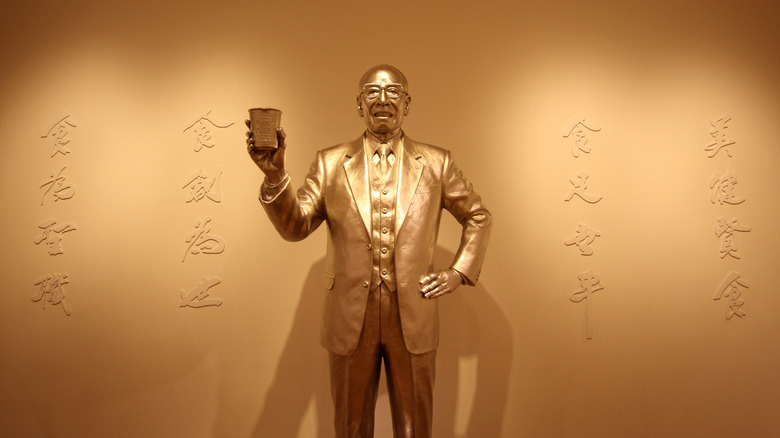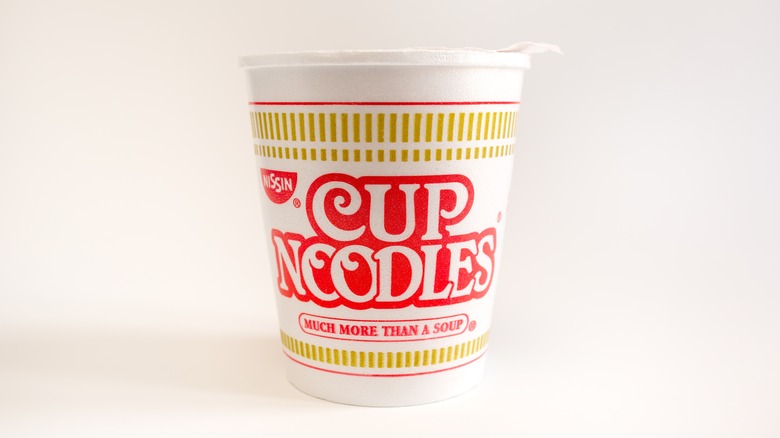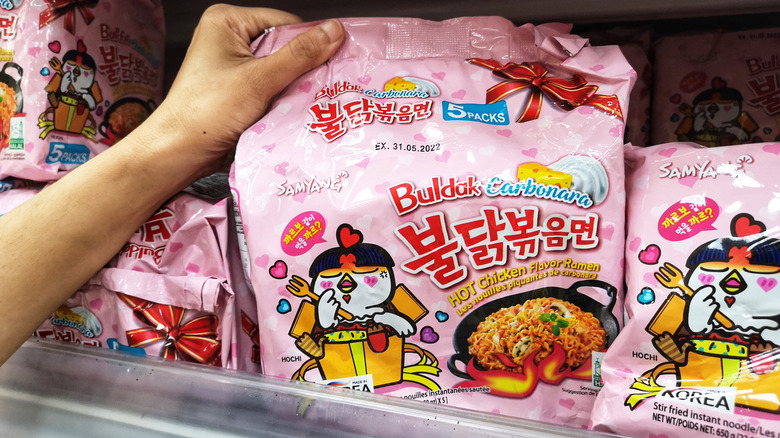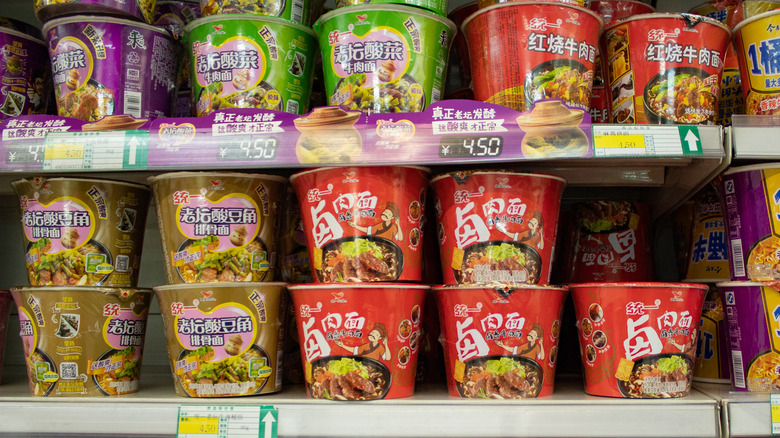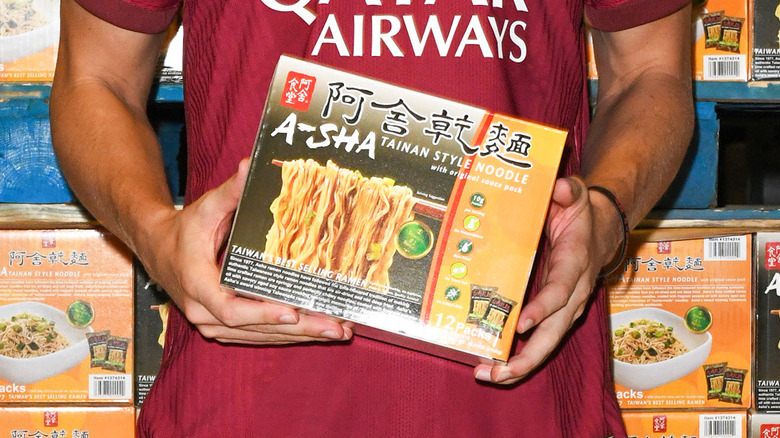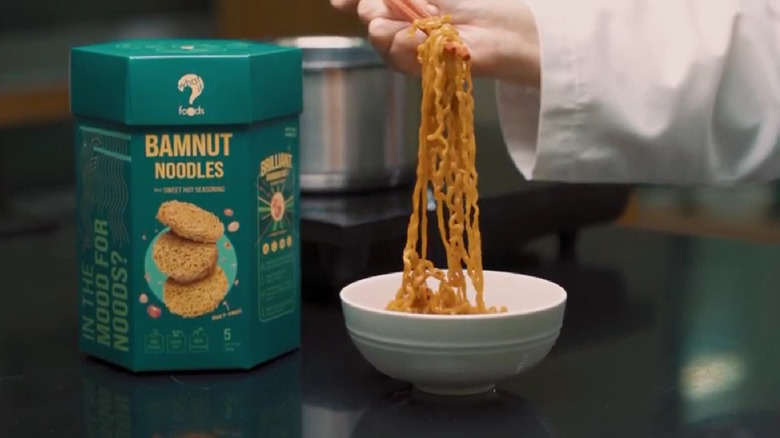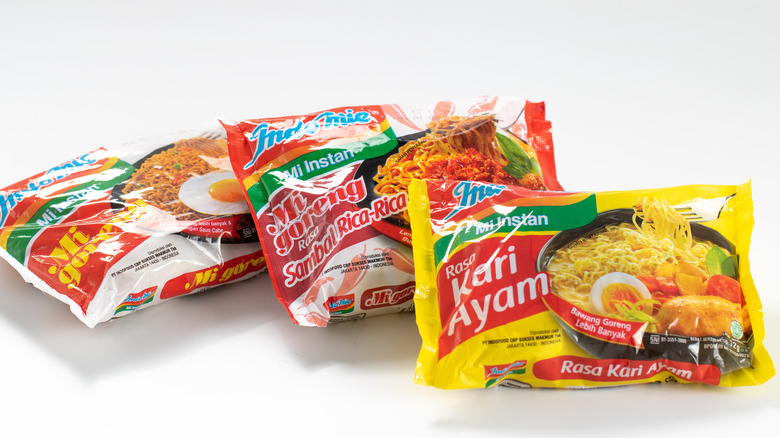The Ultimate Guide To Instant Ramen
Research by the World Instant Noodles Association would suggest the entire world is obsessed with instant ramen. The association estimates around 117 billion servings were consumed globally in 2020 alone, translating into an incredible 15 servings for every single person on Earth. While many of us may associate the three-minute meal with college dormitories and quick fixes, the truth is instant ramen plays an extremely important and multifaceted role when it comes to global diets. Japan even crowned instant ramen as the country's most important invention of the 20th century (via ABC News).
Instant ramen is adored around the world for its flavor, speed, and foolproof design. It's responsible for feeding millions of hungry people, and even fulfills the role of currency in prisons. An impressive track record for any food item, let alone one that can cost as little as $0.35 (via The Pricer). So, how has an incredibly cheap commodity come to have such a huge impact on the world? And what does the future hold for one of the world's favorite meals? The answers to these questions begin, just as instant ramen did, with a man named Momofuku Ando.
Instant ramen was invented by Momofuku Ando
Born to Taiwanese parents in March 1910, Momofuku Ando was a businessman from the get-go, launching his first at just 22 (via Nissin Foods Group). It was around this time Ando also moved from his native Taiwan to Japan. He spent the following years launching numerous companies, including a small salt company which would eventually become Nissin (via The New York Times).
It was only in the years following World War II, when Japan hovered on the brink of mass starvation (per Center for Economic Policy Research), that Ando began to entertain the idea of producing instant ramen. It took Ando, who was in his late 40s, a whole year of experimentation to achieve his five development objectives: a delicious taste, a long shelf life, easy preparation, low cost, and a safe nature. Ando's breakthrough came when he realized deep frying the noodles could dry them out before packaging, thus making them non-perishable, while the simple addition of boiling water would return them to their desired, soft state.
The fact Ando created instant ramen by himself, without the aid of food scientists, research teams, and specialists made him an icon in Japan and abroad. Despite passing away in 2007, Ando's legacy continues.
Ando was the first man to sell instant ramen in a cup
While Momofuku Ando invented instant ramen in 1958 (via Cup Noodles Museum), his company, Nissin Foods, continued to innovate long after the 1950s. According to the museum, while on a trip to America, Ando saw Western populaces preferred to eat their instant ramen in a cup, with a fork. Armed with this knowledge, Ando and the team released Cup Noodles in 1971, a time when all forms of convenience were rapidly gaining traction in Japan.
Cup Noodles were the form of instant ramen that, while popular in Japan, really broke into the American market. This was thanks to the dish's accessible nature, as each cup contained a fork, relatively familiar flavors, and the same simplicity that had made instant ramen such a hit back in Japan. Nissin opened its first American factory in 1970 in order to keep up with demand and has not looked back since, maintaining more than 30% of the North American instant noodle market.
As The Korea Herald reports, the practice of selling "cup food" is now extremely widespread, and has gone beyond just noodles to include things like rice, pasta, and stew. All of this indicates that Ando was a man well ahead of his time.
A surplus of American wheat inspired instant ramen
The Japanese population suffered immensely in the aftermath of World War II, with a lack of resources plunging millions of people into food poverty. As the country's chief occupier during the postwar years, the responsibility to feed this population largely fell to America. During this time, America was producing an overabundance of wheat. This grain was first given to Japan as aid before the new government signed a purchasing deal with the United States.
Initially, this wheat was used to make bread and other Western foods. However, one night in Osaka, Momofuku Ando came across a ramen stall which had an enormous queue. According to the South China Morning Post, Ando was struck by the Japanese demand for ramen and decided it would make much more sense to turn this surplus wheat into noodles instead of bread. This not only led to instant ramen being created, but also cemented the Japanese population's taste for wheat. Despite the efforts of the Japanese government, the dependence on American wheat has not declined, with the country importing $635 million worth of American wheat in 2020 alone.
Instant ramen is easy to upgrade
While millions of instant ramen consumers are more than happy to stick with the packet instructions, there are those who can't help but improve their instant ramen experience. Perhaps unsurprisingly, chefs and food writers are among the most prevalent upgraders. Sheldon Simeon, a chef and cookbook author, told The Strategist how he likes to improve instant noodles: "Sometimes, to make the broth even creamier, I'll crack an egg in it, stirring it directly into the soup, almost like egg-drop soup ... I add a bunch of Tabasco or black pepper. We do that at the restaurants, too — lots of black pepper in our broths."
Priya Krishna, food writer at The New York Times, prefers to add aromatics: "I love to doctor them [instant ramen] up with soy sauce and a ton of cracked black pepper, and/or sauté ginger and garlic before adding the noodles and the soup base." BBC Good Food also points out that, aside from toppings, the addition of sauces like sesame oil, fish sauce, and sriracha can also elevate a basic instant ramen.
Instant ramen acts as currency in prisons
Research performed by Ph.D. student Michael Gibson-Light found that instead of trading cigarettes, inmates at American prisons use instant ramen as currency. The Guardian reports just about every item, be it a sweater or other food items, can be bought with packets of ramen. Furthermore, inmates will also offer services, like cleaning, if paid in instant ramen. The reason why instant ramen has replaced cigarettes in the U.S. prison bartering economy is quite simple. The Federal Bureau of Prisons removed cigarettes from commissaries and banned smoking altogether during the mid-2010s, as per The Marshall Project. While tobacco can still be obtained on the black market, it's harder to come by and cannot be openly traded.
Instant ramen, on the other hand, is plentiful and has become increasingly important as meals in the prison system decline in both quality and nutritional value (via The Marshall Project). Ex-inmate and chef Ron Freeman explained his relationship with instant ramen to Vice: "Six or seven days out of the week, the food in prison, every meal is horrible. You get bologna, it looks green; you can't even make a sandwich with that stuff ... I ate ramen noodles ... You take your noodles, you add in some beef jerky for a protein, you can add tuna, all kinds of stuff, so it's a pretty big deal. Ramen actually is a product that when you're in prison, it's the only thing that kinda gives you some comfort."
Instant ramen is used to fight global hunger
Aside from being used to supplement inmates' diets, the calorific nature of instant ramen makes the product well-suited to being used as food aid. One example of how instant ramen has been used to tackle hunger comes from Japan itself. After the earthquake and tsunami rocked the country in 2011, thousands of Japanese citizens were left stranded in freezing conditions. As reported by The New York Times, vast quantities of instant ramen were shipped to these displaced people.
Outside of being used to respond to disasters, instant ramen has also been the meal of choice for many who face extremely challenging economic environments, as NPR highlights, as the product is cheap and requires minimal energy — be it electricity or gas — to make. Unfortunately, instant ramen has been found to be lacking in key nutrients. An overreliance on the product can lead to weight gain, heart and kidney issues, as well as an increased risk of stroke (via Vice), leaving impoverished populations at greater risk of ill health.
Chicken was the flavor that made instant ramen globally popular
While hot soup and noodles have a global appeal, the other ingredients included in instant ramen can be somewhat more divisive. This is for a variety of reasons, including differing tastes, religious beliefs, and traditional diets. For Momofuku Ando, this posed a big problem when he was looking to take his instant ramen global (via The New York Times), as flavors such as beef or pork could not be marketed all over the world. Fortunately, there was one meat-based flavor the vast majority of the world can get behind: chicken.
Smithsonian Magazine reports chickens are eaten the world over thanks to their mild flavor and versatility. The fact chicken was widely consumed by many cultures and most religions gave instant ramen a foothold across the globe. Consequently, it was the first flavor developed and sold by Ando. Today, chicken-flavored instant ramen remains popular, however, continents and countries also enjoy regional, specialist flavors. For example, in Indonesia, you can get salted egg instant ramen (via The Jakarta Post).
The biggest consumer of instant ramen is China
Despite being the birthplace of instant ramen, Japan is by no means the world's biggest consumer of the product. This honor goes to China, a country that emphatically dominates global instant ramen consumption. Of the approximately 117 billion servings of instant ramen sold in 2020, the Chinese population accounted for an incredible 46 billion. To put this into perspective, Indonesia, the world's second-largest instant ramen market in 2020, consumed just under 13 billion, as per the World Instant Noodles Association.
The reasons behind China's love for instant ramen are numerous, however, it seems current demand is largely being driven by the younger portion of China's population, with many time-pressured young professionals and students turning to instant ramen as a cheap and quick meal, as per China Daily. The marketing strategies of instant ramen brands throughout the 1990s helped to connect with Millennials, while still appealing to older citizens who remember when instant ramen first appeared on shelves.
Up-market instant ramen is now available
As reported by Radii, demand for instant ramen in today's younger generation hinges less on price. Instead, these consumers prioritize the use of healthier and more luxurious ingredients. Speaking to China Daily, independent food analyst Zhu Danpeng explained this change: "With the continuous upgrading of consumption, consumers' demands for instant noodles are also increasing, and young people are less sensitive to their price. It's entirely possible for instant noodles to be sold at a high price, 50 yuan [$7] even."
One brand which has capitalized on the up-market instant ramen trend is A-Sha, a Taiwanese instant ramen producer that air dries its noodles instead of the more traditional deep-frying method, as per Thrillist. However, the main way A-Sha sets itself apart is by creating new products such as the meteor noodle. Made using a patented dual blade, the surface of the noodle has textured ridges cut into it, which means the sauce coats the whole noodle much better than a conventional product.
Some brands are turning to wheat alternatives
The dominance of wheat throughout diets and food supply chains has meant that, as a species, humans are incredibly reliant on this single grain. The issues posed by this are many, especially when wheat yields are expected to drop significantly due to rising global temperatures (via The Washington Post). What's more, Livestrong reports that mass wheat consumption can lead to multiple ill effects on the human body. Consequently, wheat-free alternatives have been quick to enter all facets of the food market, and instant ramen is no exception.
One of the most prominent, wheat-free instant ramen brands comes from WhatIF Foods, a Singaporean company that utilizes the lesser-known Bambara groundnut, a legume grown in West Africa, as per CNN. Speaking to PinPoint, company CEO Christoph Langwallner explained the ethos behind WhatIF Foods' use of Bambara groundnut: "Simply being sustainable isn't enough. It's increasingly apparent that we need to restore rather than preserve our planet and by proxy, our bodies ... What we deliver in BamNut noodles not only nourishes our bodies with nutrients, but it is also made with regenerative crops that nourish the soil in which it is grown. We are also empowering farmers by ensuring them a fair share of profits from climate change-resilient crops. At the same time, we are delivering to consumers a delicious product that is healthy for them."
Innovation is the future of instant ramen
As a food that was born from innovation, it should come as no surprise that the future of instant ramen looks set to embrace new technology and processes. One brand using technology to its advantage is Immi, a company that aims to provide a healthier version of instant ramen, as per Forbes. By focusing on plant-based flavors and food technologies, Immi has produced instant ramen that is significantly lower in carbohydrates and sodium than competitors, while also containing much more protein and fiber.
While Immi has been working on innovations specific to the brand, BBC reports that another technology — freezing — can improve the quality of nearly all instant ramen. This is because freezing preserves the flavor of seasonings by not disrupting compounds in the same way drying does, meaning packets of instant ramen may well find their way into grocery store freezer aisles before too long.
Instant ramen is extremely cheap
As we have seen, instant ramen has become such a fixture of global diets due to its incredibly cheap price point. However, as with most food products, instant ramen is cheap because producers make use of inexpensive — and sometimes unsustainable — ingredients. One example of this is palm oil, which is widely used to make instant ramen. Despite certified, more sustainable versions of palm oil being available, instant ramen producers looking to cut costs frequently utilize the cheapest versions of the oil which have definitive links to deforestation, as explained by The World Wildlife Fund. The oil has also been linked with high cholesterol levels and heart disease, as per Harvard Medical School.
Even if using cheap palm oil, instant ramen producers may not be able to continue the tradition of offering super cheap products in the future as global wheat shortages drive up costs (via The Guardian). For many, this will not prove to be an issue: We have already seen there is a market capable of spending more than the minimum on instant ramen. However, for those under economic pressure who are eating instant ramen to stave off hunger or starvation, these price hikes may prove extremely costly.

